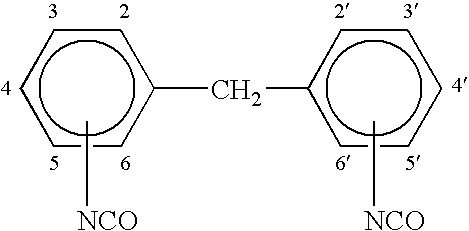Water curable polyurethane compositions with improved viscosity characteristics
a polyurethane composition and viscosity improvement technology, applied in the field of fluid compositions, can solve the problems of high vapor pressure of tdi, restricted monomer content in the formulation, and general restriction of tdi incorporated into such resins, so as to reduce foaming, reduce foaming, and reduce the effect of foaming
- Summary
- Abstract
- Description
- Claims
- Application Information
AI Technical Summary
Benefits of technology
Problems solved by technology
Method used
Image
Examples
example i
Preparation Of Sample 1
[0109]A prepolymer was prepared by mixing 43 parts by weight by weight of a 2000 molecular weight (all molecular weights refer to weight average molecular weight unless otherwise noted) polypropylene glycol diol (Pluracol P 2010) and 5 parts by weight by weight of a 4800 molecular weight polypropylene glycol triol (Pluracol P 1421) with 20 parts by weight by weight of methylene diphenyl diisocyanate (Lupemate MI). The methylene diphenyl diisocyanate was a commercial blend of about 45 to 51% by weight 4,4′-MDI and about 49 to 55% by weight 2,4′-MDI. In addition, the ingredients also included 0.2 parts by weight by weight of DBPC-BHT antioxidant and 6 parts by weight by weight of Diisononyl phthalate (DINP) as plasticizer / solvent. The ingredients were heated at about 230° F. for about 2 hours in a closed reactor vessel.
[0110]The product was an NCO functional prepolymer with an average NCO content of 6.5%. The prepolymer viscosity after cooking was 2900 cps at 80...
example 2
Preparation of Samples 2–10
[0114]Samples 2 through 10 were prepared and tested in accordance with the procedure of Example 1, except that the formulations shown in Tables 2-1 and 2-2 were used. Additionally, the catalyst dioctyltin mercaptide was used in Samples 6–10 in place of dibutyltin dilaurate. The composition and data for Sample 1 is included for comparison purposes. The amounts of ingredients shown in the tables are given on a parts by weight basis.
[0115]
TABLE 2-1SampleIngredients12345678910Prepolymer (1)Mondur ML mix of 4,4′ and 2,4′ MDI202426.5Lupernate MI mix of 4,4′ and 2,4′ MDI201626.52024Lupernate MM 103 4,4′-MDI23Rubinate 9433 mix of 4,4′ and 2,4′ MDI21Pluracol P 2010 diol434340424740.243343440.2Pluracol P 1421 triol555555.35775.3BHT antioxidant0.20.20.20.20.20.20.20.20.20.2Diisononyl phthalate6666666Propylene Carbonate565% NCO - checked6.87.037.26.74.959.356.899.169.54Viscosity CPS @ 80° F.2900217046603940376015102000215017001530
[0116]
TABLE 2-2SampleIngredients123456...
example 3
[0117]Samples 11–21 were prepared and tested in accordance with the procedure of Example 1, except that the formulations in Tables 3-1 and 3-2 were used. The amounts of ingredients shown in the tables are given on a parts by weight basis.
In the tables of this example, the following terminology was used:
[0118]Y—Yes,[0119]N—No,[0120]G—Glossy,[0121]F—Flat[0122]W—With Catalyst[0123]W / o—Without Catalyst-->Same procedure as With Catalyst except 0.02 gram of Diotyltin Mercaptide is excluded.
Procedure for checking work life for samples 11–21: @ 80° F. Take 100 grams of material and add 0.02 grams of dioctyltin mercaptide. To this mixture, add 23 grams of tap water. Mix for about 1 to 2 minutes and then check for non-flow characteristics.
[0124]
TABLE 3-1Products1112131415161718192021Prepolymer (1)Lupernate MI2020202020202020202020Pluracol P 20104343434343434343434343Pluracol P 142155555555555BHT0.20.20.20.20.20.20.20.20.20.20.2% NCO - checked7.27.27.27.27.27.27.27.27.27.27.2Viscosity CPS @ 80...
PUM
| Property | Measurement | Unit |
|---|---|---|
| molar ratio | aaaaa | aaaaa |
| weight percent | aaaaa | aaaaa |
| weight percent | aaaaa | aaaaa |
Abstract
Description
Claims
Application Information
 Login to View More
Login to View More - R&D
- Intellectual Property
- Life Sciences
- Materials
- Tech Scout
- Unparalleled Data Quality
- Higher Quality Content
- 60% Fewer Hallucinations
Browse by: Latest US Patents, China's latest patents, Technical Efficacy Thesaurus, Application Domain, Technology Topic, Popular Technical Reports.
© 2025 PatSnap. All rights reserved.Legal|Privacy policy|Modern Slavery Act Transparency Statement|Sitemap|About US| Contact US: help@patsnap.com

